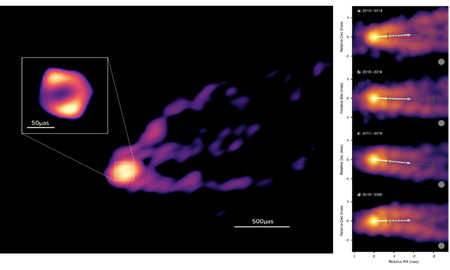Time Domain Studies and Fundamental Physics

The NRAO facilities are critical for imaging Super Massive Black Holes (SMBH) down to scales of the general relativistic shadow of the SMBH. The latest result on the SMBH in M87 (Figure 1; Cui et al. 2023) from global VLBI at 3.5mm, anchored by the VLBA, ALMA, and the GBT, shows a 64µas diameter asymmetric ring, or 8.4Rs, similar to that seen at 230 GHz by the EHT, but larger in radius by about 50%. The observations also, for the first time, trace the jet down to this ring, possibly indicating a wind driven by the accretion disk. The difference in the M87 ring radius at 90 GHz vs 230 GHz remains a puzzle. Regardless, the fact that the Global 3mm VLBI Array (GMVA) can resolve such a ring, and trace the ring-disk connection down to scales of a few Rs, opens a new window of opportunity for the ngVLA to contribute to future global VLBI experiments at 90GHz, providing dramatic improvements in both the uv-coverage and the total collecting area. Including the ngVLA in the GMVA provides baselines that can image structures from 50µas to 50” at 90 GHz. The VLBA has also recently shown a precessional period of 11 years for the M87 jet, consistent with a spinning black hole that induces the Lense-Thirring precession of a misaligned accretion disk.

The NRAO facilities also played a major role in the remarkable discovery of a background of low frequency (nanohertz) gravitational radiation, likely arising from merging supermassive black holes distributed throughout the Universe, with a possible contribution from cosmic structure formation during the inflationary epoch, within 10-32 seconds of the Big Bang. The North American Nanohertz Observatory for Gravitational Waves (NANOGrav; Figure 2; Agazie et al. 2023) project is a pulsar timing array, comprised of radio telescopes that monitor millisecond pulsars distributed across the Galaxy. Passage of large scale gravitational waves bend space time between these pulsars and the Earth, leading to a characteristic spatial and temporal signature in timing residuals on yearly timescales for the pulsar distribution. The GBT and Arecibo were the primary telescopes involved, with an important contribution from the VLA for low declination pulsars. These results are yet another extraordinary contribution by radio astronomy to our understanding of general relativity and cosmology.
The VLASS is the state-of-the-art survey of the faint, time variable radio sky. One recent discovery from the VLASS was an extreme radio flare from a likely Tidal Disruption Event (TDE)— the disruption of a star as it falls into a SMBH, in a Seyfert galaxy at z = 0.074. The radio data include a factor of 100 brightening over a decade, suggesting the formation of a relativistic radio jet over a few years, while X-ray and IR data imply the coeval development of an accretion disk. These data provide further evidence for a fundamental relationship between the formation of relativistic jets and Active Galactic Nuclei (AGN) accretion disks (Somalwar et al. ApJ, 2023, 945, 142).
Time domain and ultra-high resolution large programs continue at the VLBA for synoptic imaging of powerful radio jets, including the Monitoring Of Jets in Active Galactic Nuclei with VLBA Experiments (MOJAVE) program on radio AGN, and the Blazars Entering the Astrophysical Multi-Messenger Era (BEAM-ME) program targeting Blazars, likely to be the sources of extragalactic neutrinos. The VLA has programs geared toward studying the electromagnetic counterparts to gravitational wave sources.




Connect with NRAO